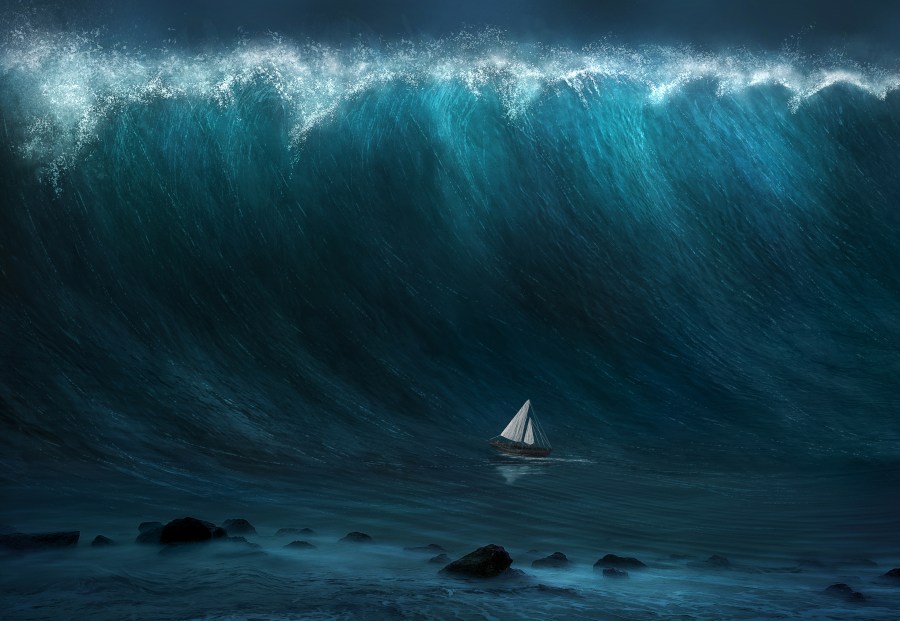HONOLULU (KHON2) — Hawaiʻi is no stranger to the ocean’s power. Most people know tsunamis as towering waves caused by earthquakes far across the Pacific.
What many do not know is that the islands themselves once created some of the biggest waves ever recorded in the geologic record.
Two massive submarine landslides, one off Oʻahu and the other off Molokaʻi, unleashed tsunamis so large that they reshaped shorelines and left behind evidence still visible today.
Nū‘anu and Wailau collapses
The Nū‘anu landslide on Oʻahu and the Wailau landslide on Molokaʻi together form one of the largest landslide complexes on Earth.
Research has shown that these volcanoes grew so fast that their flanks became unstable and collapsed. The result was an enormous mass of debris spreading for tens of kilometers across the seafloor.
Geologists believe that such collapses not only reshaped the islands but also triggered huge earthquakes, rapid shoreline changes and massive tsunamis.
Hawaiʻi’s hidden waves
Long ago the islands released two of the largest tsunamis in Earth’s history. These waves were not made by earthquakes but by landslides so large they reshaped the islands and sent water racing across the Pacific, both east and west of the island.
About 1.5 million years ago, massive sections of two volcanoes gave way. On Oʻahu, the Koʻolau Volcano collapsed in what is now called the Nū‘anu Slide.
The eastern side of the caldera became Kāneʻohe Bay, while the western side became the Koʻolau Range, which includes the lookout at Nū‘anu Pali. The debris from this event spread across 140 miles of seafloor northeast of the island.
On Molokaʻi, the northern part of East Molokaʻi Volcano broke apart in the Wailau Slide. The collapse left a giant amphitheater-shaped scar that still dominates the eastern half of the island.
It’s important to note that both slides rank amongst the largest landslides anywhere on Earth.
Waves of extraordinary size
When entire parts of these volcanoes rushed into the sea, they displaced unimaginable volumes of water. The result was colossal tsunamis.
Studies suggest waves rose hundreds of feet high and in some cases may have reached 2,000 feet. These waves slammed into nearby coasts and even traveled across the ocean to Asia and Turtle Island (now known as North America).
Evidence in stone and sea
Scientists studying the ocean floor have mapped the debris from these collapses. The seafloor shows thick piles of volcanic rock that spread out in fields that stretch for hundreds of kilometers.
On land, chaotic layers of boulders and sand mark where giant waves once surged. These deposits stand apart from normal storm layers and serve as a record of tsunamis far larger than any in modern Hawaiian history.
A paradise with a powerful past
Hawaiʻi is celebrated today as a place of beauty and adventure. Yet its landscape tells another story, one of immense geologic power.
The Nū‘anu and Wailau Slides remind us that volcanic islands can fail on a scale almost beyond imagination. The waves they unleashed reshaped shorelines and proved that paradise carries a past written in stone and water, unlike anything in recent memory.
Another giant from the north
New research has also shown that Hawaiʻi also faced a different kind of threat about 500 years ago. A magnitude 9.0 earthquake in the Aleutian Islands in Alaska sent a tsunami up to 30 feet high onto Kauaʻi.
Scientists found layers of coral fragments, shells and sand inside the Makauwahi sinkhole that reveal how powerful the wave was. The deposit equaled the volume of several shipping containers.
The study concluded that the tsunami was at least three times larger than the destructive 1946 event, which had been Hawaiʻi’s worst in modern times. The 500-year-old tsunami was so strong because the shape of the Aleutian trench directed much of its energy straight toward Hawaiʻi.
Lessons for today
Honolulu officials have already revised evacuation maps to account for the chance of such extreme waves.
That means more land is now included in potential danger zones. While tsunamis of this size are rare, the evidence shows that Hawaiʻi has faced waves far larger than any in its recorded history.
For more information on these tsunami research patterns, you can look here, here, here, here, here, here, here, here and here.
For island communities surrounded by ocean, the lesson is clear: the past carries warnings that remain urgent today.
